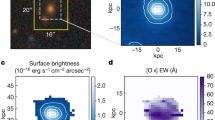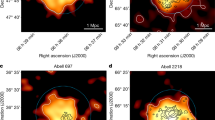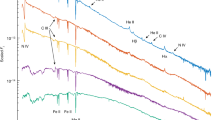Abstract
Current radio catalogues1,2 list some 145 sources as galactic supernova remnants which are included primarily on the basis of their exhibiting a nonthermal radio spectrum, evidence for extended emission and being located within a few degrees of the galactic plane. Detailed maps including spatially-resolved spectral information and polarimetric data have been obtained for about half of the catalogued objects, primarily those lying within ∼5 kpc of the Sun, and have revealed three classes of remnants: shell-like sources, Crab-like synchrotron nebulae and composite remnants3,4 containing a central Crab-like component surrounded by a shell. While mapping many of the remnants not well studied to date, we have discovered at least two nonthermal extended objects which defy classification in any of these categories. The two sources exhibit a marked axial symmetry with evidence for a compact component at one extreme of the axis. Their diffuse emission includes bright filamentary structures superimposed on a lower surface brightness component which gradually fades, becoming undetectable at the end of the axis opposite the compact source. The mean spectral indices of these sources are intermediate between the shell- and Crab-like remnants. We propose here that these objects are representative of a new class of nonthermal radio sources; elsewhere in this issue5, we suggest that such sources are formed through the emission of relativistic particles produced by high-velocity accreting binary systems.
This is a preview of subscription content, access via your institution
Access options
Subscribe to this journal
Receive 51 print issues and online access
$199.00 per year
only $3.90 per issue
Buy this article
- Purchase on Springer Link
- Instant access to full article PDF
Prices may be subject to local taxes which are calculated during checkout
Similar content being viewed by others
References
Milne, D. E. Aust. J. Phys. 32, 83–92 (1979).
Green, D. A. Mon. Not. R. astr. Soc. 209, 449–478 (1984).
Becker, R. H. & Helfand, D. J. Astrophys. J. 283, 154–157 (1984).
Weiler, K. W. IAU Symp. No. 101, 299–320 (1984).
Helfand, D. J. & Becker, R. H. Nature 313, 118–119 (1984).
Green, A. J. Astr. Astrophys. Suppl. 18, 267–307 (1974).
Author information
Authors and Affiliations
Rights and permissions
About this article
Cite this article
Becker, R., Helfand, D. A new class of nonthermal radio sources. Nature 313, 115–118 (1985). https://doi.org/10.1038/313115a0
Received:
Accepted:
Issue Date:
DOI: https://doi.org/10.1038/313115a0
This article is cited by
-
A large age for the pulsar B1757-24 from an upper limit on its proper motion
Nature (2000)
-
New pulsar/supernova remnant associations
Journal of Astrophysics and Astronomy (1995)
-
Illumination of the Supernova remnant G5.3-1 (=bird) by its pulsar PSR 1757-24
Astrophysics and Space Science (1992)
-
Pulsar nebulae
Astrophysics and Space Science (1992)
-
Unusual interaction of the high-velocity pulsar PSR1757–24 with the supernova remnant G5.4–1.2
Nature (1991)
Comments
By submitting a comment you agree to abide by our Terms and Community Guidelines. If you find something abusive or that does not comply with our terms or guidelines please flag it as inappropriate.



